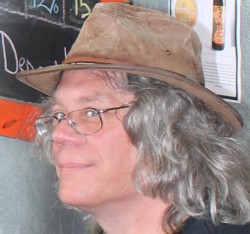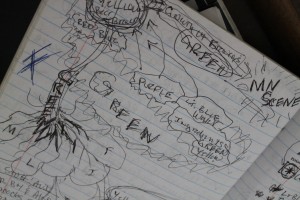The film gets a score
 I’m always pleasantly surprised when I watch Crafted to Last – Minnesota Beer Blossoms and once again realize how closely it resembles the film I pictured in my head while making it. The main lesson I learned was that many more voices could be included in the film. My original target was 8-10 people in the film because I thought that too many voices might be confusing. To my great delight I soon began to understand that when many voices speak intelligently and with passion about the same subject, more is definitely better. Thirty-six people appear in the documentary and I think we could have squeezed in a few more. The idea was to create a narrative track that is basically one long conversation between all the people appearing in the film. Recording the speakers in pairs set the stage for this because it brings the viewer into the conversation as they listen with the silent on-screen partner.
I’m always pleasantly surprised when I watch Crafted to Last – Minnesota Beer Blossoms and once again realize how closely it resembles the film I pictured in my head while making it. The main lesson I learned was that many more voices could be included in the film. My original target was 8-10 people in the film because I thought that too many voices might be confusing. To my great delight I soon began to understand that when many voices speak intelligently and with passion about the same subject, more is definitely better. Thirty-six people appear in the documentary and I think we could have squeezed in a few more. The idea was to create a narrative track that is basically one long conversation between all the people appearing in the film. Recording the speakers in pairs set the stage for this because it brings the viewer into the conversation as they listen with the silent on-screen partner.
I had planned from the outset to break up the conversation with some sort of digression or a musical interlude, but the final context and content of what would become the Water and Beer Interludes was far from certain. There were a lot of ideas along the way. Animations, customer comments, history lessons, all were pursued to one extent or another. Both interludes were ways to include material that would have otherwise been deleted from the film. The discussions of water and descriptions of beers were too long and had not found a stable place in the time line. I had already made the dialogue track for the Water Interlude before Zack Lozier ever saw the film. He wrote and recorded “Here Come the Water” in the first round. The success of the Water Interlude in saving that dialogue from the edit suite floor encouraged me to revisit the brewers describing their beers. The result was the experimental Beer Interlude where we play around with sound and image.
I had worked with Zack’s music before I ever met him. Jesse Brödd sent me an MP3 of Fallout by one of his bands, Big Blue Station Wagon, to use in a short video I made for the 1 year anniversary of the Harriet Brewing Tap Room. The result – Three Minute Tap Room – compresses the build out of the tap room over roughly 3-4 months into approximately 3 minutes. The Tap Room Time Progression video is a critical element of the film. It is a visual rendition of what happened in MN when the tap room/pint/Surly Bill became the law of the land. Fragments of it show up multiple times in Crafted to Last and there is even a sense of the full progress of time when Jason and Jesse tell us about the controlled chaos of the build out, but nothing captures the dynamism and kinetics like Three Minute Tap Room. The music of Big Blue Station Wagon had pushed me in the right direction.
The plan was to make a documentary without a narrator or an interviewer. This puts more weight on the sound track, specifically the score to delineate parts of the movie and set the emotional context. Working with a local musician to compose an original score was in tune with a theme of local community that resonates throughout the narratives of the people in the film. After a few dead ends, I finally talked to Zack Lozier and he agreed to meet at Town Hall Lanes.
We talked about music, moods and what I wanted to accomplish with the score. I explained my perspective that film is composed of 3 tracks. Dialogue, Sound and Image. I would sculpt the Dialogue track from all the people narrating the film and assemble the Image track from A, B and C Roll video. Zack would create the film score; the main element of the sound track. He was intrigued by the project because it challenged him to compose a lot of new music and to collaborate with a film maker. Something he wanted to do and something he had never done before. He agreed to experiment first and ask questions later, so the deal was done.
 I gave Zack a very early rendition of the film so that he could get a sense of what we had and where it was going. He is one of a very select cohort lucky enough to have seen Crafted to Last in its entirety without the B Roll video. Even so, he was able to discern the general themes in the film and begin making music to enhance the story. To give him a visual image that summarized the gist of the film I explained the scribbled diagram pictured to the left because it depicts the basic structure of the film. It shows a dessicated seed bursting out when suffuse with sparkling water that grows into a healthy plant well rooted in the local nurturing soil and then blossoming forth into full, succulent blooms. Each of the home brewers that went on to be featured in Crafted to Last are like the seeds, their breweries are the plants, and everything that comes from them are the blossoms. Reform of the distribution laws was like rain watering the seeds and stimulating them to grow in the rich soil of the local neighborhood.
I gave Zack a very early rendition of the film so that he could get a sense of what we had and where it was going. He is one of a very select cohort lucky enough to have seen Crafted to Last in its entirety without the B Roll video. Even so, he was able to discern the general themes in the film and begin making music to enhance the story. To give him a visual image that summarized the gist of the film I explained the scribbled diagram pictured to the left because it depicts the basic structure of the film. It shows a dessicated seed bursting out when suffuse with sparkling water that grows into a healthy plant well rooted in the local nurturing soil and then blossoming forth into full, succulent blooms. Each of the home brewers that went on to be featured in Crafted to Last are like the seeds, their breweries are the plants, and everything that comes from them are the blossoms. Reform of the distribution laws was like rain watering the seeds and stimulating them to grow in the rich soil of the local neighborhood.
Amazingly, that was enough to inspire Zack to make an entire film score of new music with a cohort of players culled from around the Twin Cities. A couple more rounds of feedback and adding instruments to the mix and we had the music for the film. Working with Zack was a pleasure and it notably enhanced the film. That success encouraged us to take on the more experimental parts of the film. Where the Water interlude minimally digresses from the film to bring in lyrics from the score, the Beer interlude goes further as we mix dialogue and image with a more restrained score that echoes fermentation in the beat. These brief interludes distinguish Crafted to Last from other films about craft brewing and they came about organically while collaborating with Zack to create the score. These are my favorite parts of the film for these and many other reasons. Enjoy.


Comments are Closed